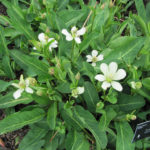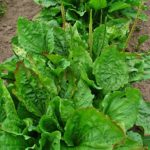
Anemopsis californica flickr photo by wallygrom shared under a Creative Commons (BY-SA) license
For the Summer 2018 Trimester I conducted a 0.5 credit hour with American Herbal Pharmacopoeia. Under the supervision of the AHP Executive Director Roy Upton I contributed to the upcoming monograph on Anemopsis Californica. This monograph will serve a complete and critical review of the traditional and scientific literature regarding the efficacy and safety of yerba mansa. I feel especially lucky to be working on a monograph with AHP because I feel that it is an organization conducting vitally important work for the field of herbal medicine. My perspective is that there is a direct association between the work that Lloyd, Felter, Scudder and King etc were doing a century ago and the work that AHP is doing now.
Aside from the deliverables, the metrics associated with a quality internship program necessarily center around the opportunities it provides for students to develop the soft skills that will facilitate their transition to professional life. This internship experience challenged me to continue developing competency in many of the soft skills articulated in as learning goals for the internship. Four skills that I was able to identify significant self progress in are: Written communication skills, the MUIH value of discernment, critical thinking skills, and professionalism.
While the monograph is ultimately the intellectual property of AHP a small sample of the work I conducted for the internship can be exemplified by this chart of the ethnobotanical use of Anemopsis.
|
Communities |
Reference |
|
|
Internal Use |
||
|
Colds |
Tübatulabal , Maricopa, Pima, Diné, Luiseño and Chumash Pericú Chumash and southern Paiute |
Larsen 1992; Wheeler- Voegelin 1938; Wyman and Harris 1979; Dimayuga et al.; Russell 1908; Stoffle and Dobyns 1982; 1983; Timbrook 2007; Train etal 1974 |
|
Dysentery |
Yaqui and Tarumari |
Boido 1894 |
|
Diuretic |
Diné |
Wyman and Harris 1979 |
Tuberculosis |
Diné, Pima |
Wyman and Harris 1979; Russell 1908 |
|
Gangrene |
Yaqui and Tarumari |
Boido 1894 |
|
General pain |
Chumash and
southern Paiute,
Kumeyaay
|
Russell 1908; Stoffle and Dobyns 1982, 1983; Timbrook 2007; Train et al. 1974; (Wilken, 2012) |
menstrual cramps |
Costanoan, Ohlone |
Bocek 1984 |
Blood purifier |
Luiseño and Chumash |
Gardner 1965; Jepson 1909; Kroeber et al. 1908; Sparkman 1908; Train et al. 1974 |
|
Asthma |
Luiseño and Chumash Paiute |
Gardner 1965; Jepson 1909; Kroeber et al. 1908; Sparkman 1908; Train et al. 1974; Rhode 2002 |
|
Indigestion |
Chumash and
southern Paiute,
Kumeyaay
|
Russell 1908; Stoffle and Dobyns, 1982, 1983; Timbrook 2007; Train et al 1974; (Wilken, 2012) |
Venereal disease |
Tübatulabal ,
Maricopa, Pima
Chumash and
southern Paiute,
Hopi
|
Larsen 1992; Wheeler- Voegelin 1938; (Sánchez, 1999) |
|
Emetic |
Papago, Pima |
Castetter and Underhill 1935; Russell 1908 |
|
Diabetes |
Tübatulabal , Maricopa, Pima |
Larsen 1992; Wheeler- Voegelin 1938 |
|
Malaria |
Yaqui and Tarumari |
Boido 1894 |
|
Topical Use |
||
Wounds Bruises and Sores |
Luiseño and Chumash Yaqui and Tarumari Pericú Costanoan Zuni, Pueblo, Navajo, Kumeyaay, Hopi |
Gardner 1965; Jepson 1909; Kroeber et al. 1908; Sparkman 1908; Train et al. 1974 Dimayuga et al.; Bocek 1984; Curtin 1997; (Wilken, 2012); (Sánchez, 1999) |
|
Rheumatism |
Paiute |
Train et al., 1974; Larsen 1992 |
|
Gargle |
Zuni, Pueblo,
Navajo
|
Curtin 1997 |
Anemopsis californica flickr photo by wallygrom shared under a Creative Commons (BY-SA) license

